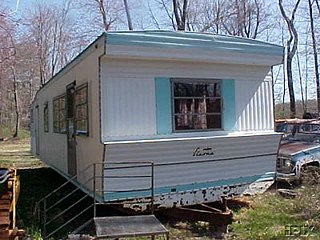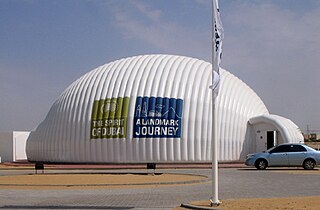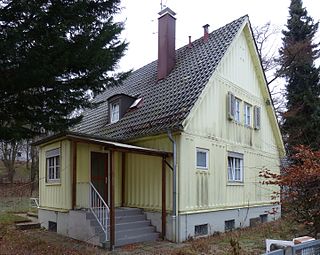 W
WA portable, demountable or transportable building is a building designed and built to be movable rather than permanently located.
 W
WThe Bessonneau hangar was a portable timber and canvas aircraft hangar used by the French Aéronautique Militaire and subsequently adopted by the Royal Naval Air Service (RNAS) and the Royal Flying Corps (RFC) during the First World War. Many Bessonneau hangars were also subsequently used by the fledgling Royal Air Force (RAF) as temporary structures until more permanent facilities could be built such as at RAF Cleave.
 W
WA blister hangar is a novel arched, portable aircraft hangar designed by notable British airport architect Graham R Dawbarn patented by Miskins and Sons in 1939. Originally made of wooden ribs clad with profiled steel sheets, steel lattice ribs and corrugated steel sheet cladding later became the norm. It does not require a foundation slab and can be anchored to the ground with iron stakes. Numerous examples were manufactured for military use in World War 2 and various different sizes were available. Many found post-war use as agricultural or industrial buildings and some still remain in use on airfields such as Fairoaks, Redhill, Coal Aston and White Waltham today. Denham Aerodrome still uses their blister hangar to house the only fixed wing flying school on the field, The Pilot Centre.
 W
WA campervan, sometimes referred to as a camper, caravanette, or motor caravan, is a self-propelled vehicle that provides both transport and sleeping accommodation. The term mainly describes vans that have been fitted out, often with a coachbuilt body for use as accommodation.
 W
WCaravan is an Israeli term referring to a portable building used as a living space, school classroom, synagogue, or community center.
 W
WA chicken tractor is a movable chicken coop lacking a floor. Chicken tractors may also house other kinds of poultry. Most chicken tractors are a lightly built A-frame which one person can drag about the yard. It may have wheels on one or both ends to make this easier.
 W
WA halting site is purpose-built residential accommodation for Travellers provided by a local municipal authority. The halting site has an individual bay for each family unit with a full range of services provided in a small structure on each bay.
 W
WA mobile home is a prefabricated structure, built in a factory on a permanently attached chassis before being transported to site. Used as permanent homes, or for holiday or temporary accommodation, they are left often permanently or semi-permanently in one place, but can be moved, and may be required to move from time to time for legal reasons.
 W
WAn ice shanty is a portable shed placed on a frozen lake to provide shelter during ice fishing. They can be as small and cheap as a plastic tarp draped over a frame of two-by-fours, or as expensive as a small cabin with heat, bunks, electricity and cooking facilities.
 W
WThe iLoo was a cancelled Microsoft project to develop a Wi-Fi Internet-enabled portable toilet. The iLoo, which was to debut at British summer festivals, was described as being a portable toilet with wireless broadband Internet, an adjustable plasma screen, a membrane wireless keyboard, a six-channel speaker system, and toilet paper embossed with popular web site addresses. The iLoo was also to have an extra screen and keyboard on the outside, and was to be guarded. It was intended as the next in a series of successful initiatives by MSN UK which sought to introduce the internet in unusual locations, including MSN Street, MSN Park Bench and MSN Deckchair.
 W
WAn inflatable building is a structure constructed using two layers of membrane connected together, typically using spars made from the same material. The cavity formed between the layers is pressurized with air producing a rigid structural element which allows large span structures to be achieved. The key difference between air-supported buildings and inflatable buildings is that air-supported buildings require airlocks at all the access points to prevent air being lost when doors are opened since the entire occupied space of the building is pressurized.
 W
WA living van is a portable caravan, used by the itinerant crew of a traction engine.
 W
WThe MAN steel house was a pre-fabricated building by MAN. A total of 230 units were built worldwide from 1948 to 1953.
 W
WMobile Home Construction and Safety Standards Act of 1974 or National Mobile Home Construction and Safety Standards Act is a United States federal law establishing design and development safety standards for manufactured housing or prefabricated homes. The codified law authorized stipulations whereas any proposed safety standard shall be equitable for a particular type of mobile home with consideration of additional cost liabilities for the future homeownership. The Act of Congress endorsed violative civil penalties and judicial review of Federal mobile home construction and safety standards developed by the United States Department of Housing and Urban Development. The Act mandated the establishment of the National Mobile Home Advisory Council and National Mobile Home Administration.
 W
WA mobile office is an office built within a truck, motorhome, trailer or purpose built shipping container. Most common are towable offices built on an axled iron frame for easy relocation.
 W
WA motorhome is a type of self-propelled recreational vehicle (RV) which offers mobile living accommodation.
 W
WA pole marquee or pole tent is a variety of large tent often used to shelter summer events such as shows, festivals, and weddings. They are particularly associated with typical English country garden weddings and village fetes.
 W
WPollee is a mobile female urinal, designed by Nuala Collins, Christian Pagh and Sara Nanna and produced by the Danish design bureau UIWE. It is specifically designed to be used at public events such as concerts or music festivals.
 W
WA polytunnel is a tunnel typically made from steel and covered in polyethylene, usually semi-circular, square or elongated in shape. The interior heats up because incoming solar radiation from the sun warms plants, soil, and other things inside the building faster than heat can escape the structure. Air warmed by the heat from hot interior surfaces is retained in the building by the roof and wall. Temperature, humidity and ventilation can be controlled by equipment fixed in the polytunnel or by manual opening and closing of vents. Polytunnels are mainly used in temperate regions in similar ways to glass greenhouses and row covers. Besides the passive solar heating that every polytunnel provides, every variation of auxiliary heating is represented in current practice. The nesting of row covers and low tunnels inside high tunnels is also common.
 W
WA pop-up canopy is a shelter that collapses down to a size that is portable. Typically, canopies of this type come in sizes from five feet by five feet to ten feet by twenty feet. Larger or semi-permanent canopies are known as "marquees".
 W
WA portable classroom, is a type of portable building installed at a school to temporarily and quickly provide additional classroom space where there is a shortage of capacity. They are designed so they may be removed once the capacity situation abates, whether by a permanent addition to the school, another school being opened in the area, or a reduction in student population. Such buildings would be installed much like a mobile home, with utilities often being attached to a main building to provide light and heat for the room. Portable classrooms may also be used if permanent classrooms are uninhabitable, such as after a fire or during a major refurbishment.
 W
WA portable or mobile toilet is any type of toilet that can be moved around, some by one person, some by mechanical equipment. Most types do not require any pre-existing services, such as sewerage disposal, but are completely self-contained.
 W
WQarmaq is an Inuktitut term for a type of inter-seasonal, single-room family dwelling used by Inuit. To the Central Inuit of Northern Canada, it refers to a hybrid of a tent and igloo, or tent and sod house. Depending on the season, the lower portion was constructed of snow blocks or stone, while the upper portion used skins or canvas. To the Kalaallit of Greenland, qarmaq refers to the dwelling's wall. Qarmaq were built in the transitional seasons of fall and spring with a circular wall of stone, sod, or blocks of snow, a framework usually made from animal bones, which were covered with a skin.
 W
WA Quonset hut is a lightweight prefabricated structure of corrugated galvanized steel having a semi cylindrical cross-section. The design was developed in the United States, based on the Nissen hut introduced by the British during World War I. Hundreds of thousands were produced during World War II and military surplus was sold to the public. The name comes from the site of their first manufacture at Quonset Point at the Davisville Naval Construction Battalion Center in Davisville, Rhode Island.
 W
WA Rubb Hall is a commercial name for particularly large, relocatable tent-like structure often used in situations of emergency and temporary industry. The name derives from Rubb Building Systems, and Hall Engineering of Bergen Norway, manufacturers of this kind of structure. Other types of similar structure include Wiik Halls.
 W
WA living van is a portable caravan, used by the itinerant crew of a traction engine.
 W
WThe Spartan Aircraft Company was an American aircraft manufacturing company, headquartered on Sheridan Avenue near the Tulsa Municipal Airport in Tulsa, Oklahoma. Previously known as Mid-Continent Aircraft Company, the company had been reorganized under the Spartan name in 1928 by oil baron William G. Skelly — and operated until 1961, manufacturing aircraft, aircraft components, and recreational vehicle trailers. The company was known for the luxurious Spartan Executive aircraft produced in the late 1930s and early 1940s — made prominent by owners such as Howard Hughes and King Ghazi of Iraq.
 W
WA tent is a shelter consisting of sheets of fabric or other material draped over, attached to a frame of poles or attached to a supporting rope. While smaller tents may be free-standing or attached to the ground, large tents are usually anchored using guy ropes tied to stakes or tent pegs. First used as portable homes by nomads, tents are now more often used for recreational camping and as temporary shelters.
 W
WA tipi, also tepee or teepee and often called a lodge in older English writings, is a tent, traditionally made of animal skins upon wooden poles. Modern tipis usually have a canvas covering. A tipi is distinguished from other conical tents by the smoke flaps at the top of the structure.
 W
WA trailer park or caravan park is a temporary or permanent area for mobile homes and travel trailers. Advantages include low cost compared to other housing, and quick and easy moving to a new area, for example when taking a job in a distant place while keeping the same home.
 W
WThe Twynham hut was developed by the British War Office in 1959 as a replacement for the Nissen hut which was first used in 1916. It was constructed of individual 8-foot (2.4 m) bays which made the roof stronger than that of its predecessor. Huts are known to have been constructed in lengths between 16 feet (4.9 m) and 128 feet (39 m). Although four times the cost of Nissen huts the Twynham hut was considered more comfortable and aesthetically pleasing; it also had twice the design life and could be fitted with air conditioning. The huts remained in use until at least 1982.
 W
WA Yaranga is a tent-like traditional mobile home of some nomadic Northern indigenous peoples of Russia, such as Chukchi and Siberian Yupik.